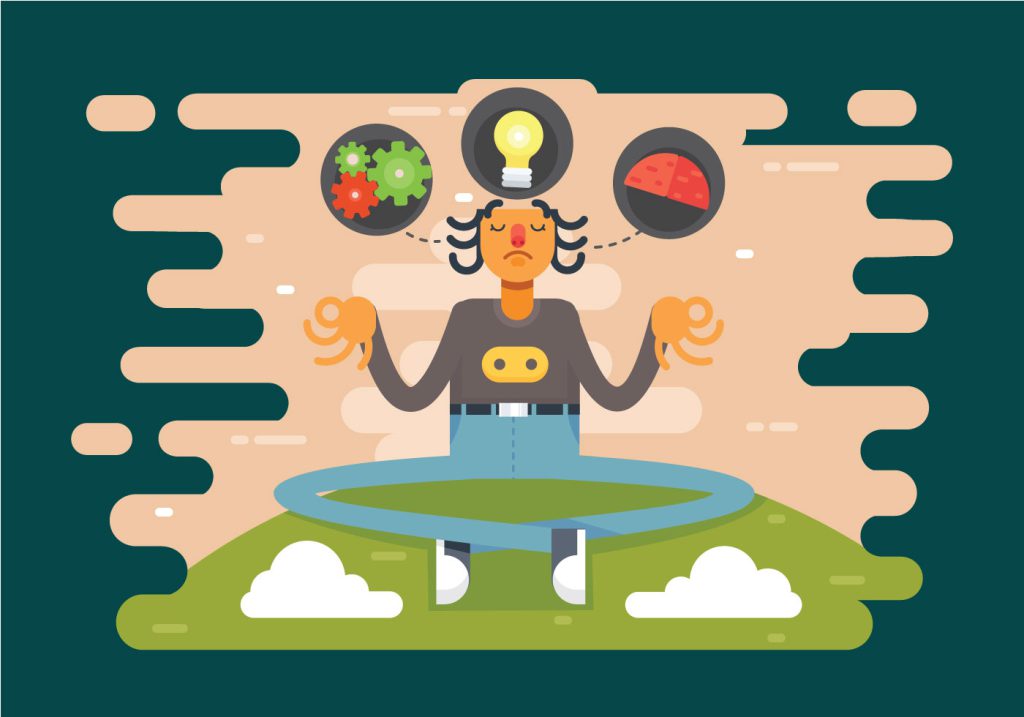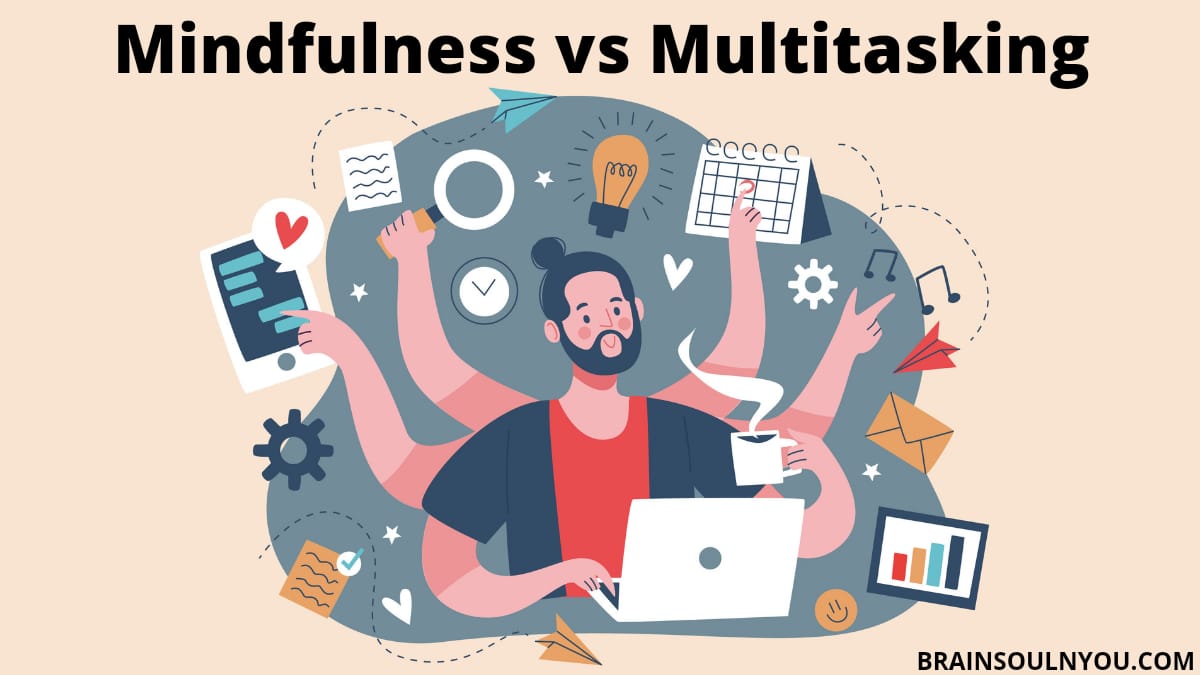Often people have confusions that which is better mindfulness or multitasking. Because everyone feels that by multitasking, all their work gets done simultaneously, time is also saved. But focusing on a single task only does one thing. So, most people think that multitasking is better than mindfulness.
What is mindfulness?
Mindfulness is the basic human ability to be fully present, aware of where we are and what we are doing, and not be overly reactive or overwhelmed by what is happening around us. It is the state of being fully aware of your surroundings.

What is multitasking?
Multitasking is doing different work at one time. Multitasking seems like a great way to do a lot at once. But research has shown that our brains are not as good at handling many tasks as we think they are. In fact, some researchers suggest that multitasking can actually reduce productivity by up to 40%.
Which is Better Mindfulness or Multitasking?
By the above explanation of mindfulness and multitasking, you can clearly find which is better: mindfulness or multitasking. Mindfulness is better than multitasking. In actuality, multitasking is a myth.
Why multitasking is a myth?
It may seem like you are doing several things at the same time, but what you are really doing is shifting your focus and attention from one thing to another. Switching from one task to another makes it difficult to remove distractions and can create mental blocks that can slow you down. In actuality, multitasking is a productivity killer.

Take a moment and think about all of the things you are doing right now. Obviously, you are reading this article, but chances are good that you are also doing several things at once. Perhaps you’re also listening to music, texting a friend, checking your email in another browser tab, or playing a computer game.
If you are doing several different things at once, then you may be what researchers refer to as a “heavy multitasker.” And you probably think that you are fairly good at this balancing act. According to several different studies, however, you are probably not as effective as you think you are.
Research has demonstrated that switching from one job to another has a serious impact on productivity. Multitaskers have more trouble with distractions than people who focus on one task at a time. Also, doing too many different things at once can actually reduce cognitive ability.
In addition to the fact that you are confronted with settling on a large number of choices every day, performing multiple tasks has likewise turned into the standard for occupied and popular experts. The issue is, that performing multiple tasks harms more than it makes a difference. The more you partition your consideration through performing multiple tasks, the more your efficiency diminishes.
In a review, self-portrayed multitaskers were approached to switch to and fro between undertakings at a speed that felt normal to them. A benchmark group was approached to do each work in turn in succession. The performing various tasks bunch performed undeniably less actually. Each time they exchanged undertakings, there was a stoppage since it required investment to time review the subtleties and the means they’d done as such far. This injury up making everything take generally 40% longer and prompted lower levels of exactness by and large. Individuals who zeroed in on each errand, in turn, invested less energy in general and followed through with every one of the jobs.
How to stop multitasking?
The only way to stop multitasking is to practice mindfulness. If you concentrate on one task you automatically stop multitasking. There are some better ways for practicing mindfulness.
Focus on important things
If you have so many works to do then identify which task is most important. Focus on the most important things. After completing that task shifts to the next important thing.
Use the “20-minute rule.
Instead of constantly switching between tasks, try devoting your attention completely to one task for 20 minutes before switching to another.
Use effective time management solutions
There are productivity tools and resources that will enable you to be the master of your schedule. Chunking is an effective method that can help you improve productivity. Instead of being overwhelmed by the many tasks currently on your agenda, look at your schedule and see which items can be grouped together based on similar desired outcomes. A group with items that will produce similar results. By sorting your activities into more actionable items, you reduce the length of your to-do list and make the day ahead feel less overwhelming.
Know When to Say “No”
The most successful people in the world aren’t the ones who try to take everything – they’re the masters of time management who know what they should be investing their time in. You want to be seen as helpful and productive at work, so you often say “yes” to whatever you’re asked. But over time, you’ll find that you have too much on your plate. It creates tension and takes your focus away from the things you can work on. Learn to say “no” when a task doesn’t fit your schedule.
Build Better Habits
In the end, it’s important to identify bad habits and work to create positive ones. If you know you work better in the evening, sleep longer in the morning, and stay in the office longer at night. Do you find that your brain works better after you exercise? Set your alarm early and hit the gym before you go to work.
When you know what it takes to feel fulfilled and productive at work, try to develop habits that allow you to feel that way. Identify activities that make you feel powerful and productive, and allow yourself to do them as often as possible. Part of building good habits includes taking breaks when needed. As much as you want to be in the office all day, you cannot work effectively without regular rest and recharge.
Mindfulness vs Multitasking: Pick Mindfulness
Mindfulness vs Multitasking: The brain works ideally when it can zero in on each movement in turn. Picking care over performing multiple tasks will bring about better sentiments over your day and assist you with accomplishing better work.
“Care” can be characterized as being cognizant and mindful. It truly is tied in with being available at the time and concentrating on what’s within reach. There are many benefits to care in the work environment. The stunt is making limits and propensities that permit you to focus on each errand.
Adopt a proactive strategy and make a focused plan of the things that should finish every day. This will permit you to gain genuine headway on a couple of things that are significant as opposed to being receptive. Each thing that goes on your daily agenda ought to be discrete, clear, and noteworthy. Center around three to five undertakings each day.
Multitasking isn’t always bad
Some research suggests that people who engage in media multitasking (using more than one type of media or type of technology at once) may be better able to integrate visual and auditory information. Study participants between the ages of 19 and 28 were asked to complete questionnaires regarding their media use. Media multitasking may not always be a bad thing.
Conclusion: Now you can easily understand that mindfulness is better than multitasking. Multitasking is just a myth. So, practice mindfulness.
Frequently Asked Questions (FAQs)
- What is mindfulness, and how does it differ from multitasking?
Mindfulness is the ability to be fully present and aware of the current moment, avoiding overwhelm or reactivity. On the other hand, multitasking involves doing multiple tasks simultaneously. Mindfulness emphasizes focused attention, while multitasking divides attention between different activities. - Is multitasking truly effective, or is it just a myth?
Multitasking is often considered a myth, as research indicates that our brains struggle to handle multiple tasks simultaneously. Studies suggest that multitasking can reduce productivity by up to 40%, creating mental blocks and distractions. Focusing on one task at a time is generally more effective. - How can mindfulness improve productivity and focus?
Mindfulness enhances productivity by promoting focused attention on a single task. By being fully present and aware, individuals can avoid the negative impacts of multitasking, such as reduced cognitive ability and increased processing time. Mindfulness helps create a more efficient and accurate work environment. - What are practical ways to stop multitasking and practice mindfulness?
To stop multitasking, it’s essential to prioritize tasks, use the “20-minute rule” (dedicating full attention to one task for 20 minutes), employ effective time management solutions, and learn to say “no” when necessary. Building better habits, including regular breaks, also contributes to improved focus. - Is there a balance between mindfulness and multitasking in the workplace?
While mindfulness is generally more beneficial for productivity, some research suggests that media multitasking, under specific conditions, may have advantages. However, the key is to adopt a proactive approach, create focused daily plans, and prioritize tasks, finding a balance that suits individual work styles.
Also, read Ichigyo-Zammai: The Practice of full Concentration, Kanban System: The Formula of Clarity
Love,
Saurabh Goel
Saurabh Goel
Saurabh Goel is the Founder and CEO of the Training and Counselling Company Brain Soul & You’. He is an NLP Wellness Coach, Life Coach, Brain analyst, and Trainer for Education, Corporate, and Entrepreneurship. For more than 5 years, he delivered presentations on entrepreneurship, mind programming, and motivation. He did his B.tech in IT and later choose to be a successful psychologist.


